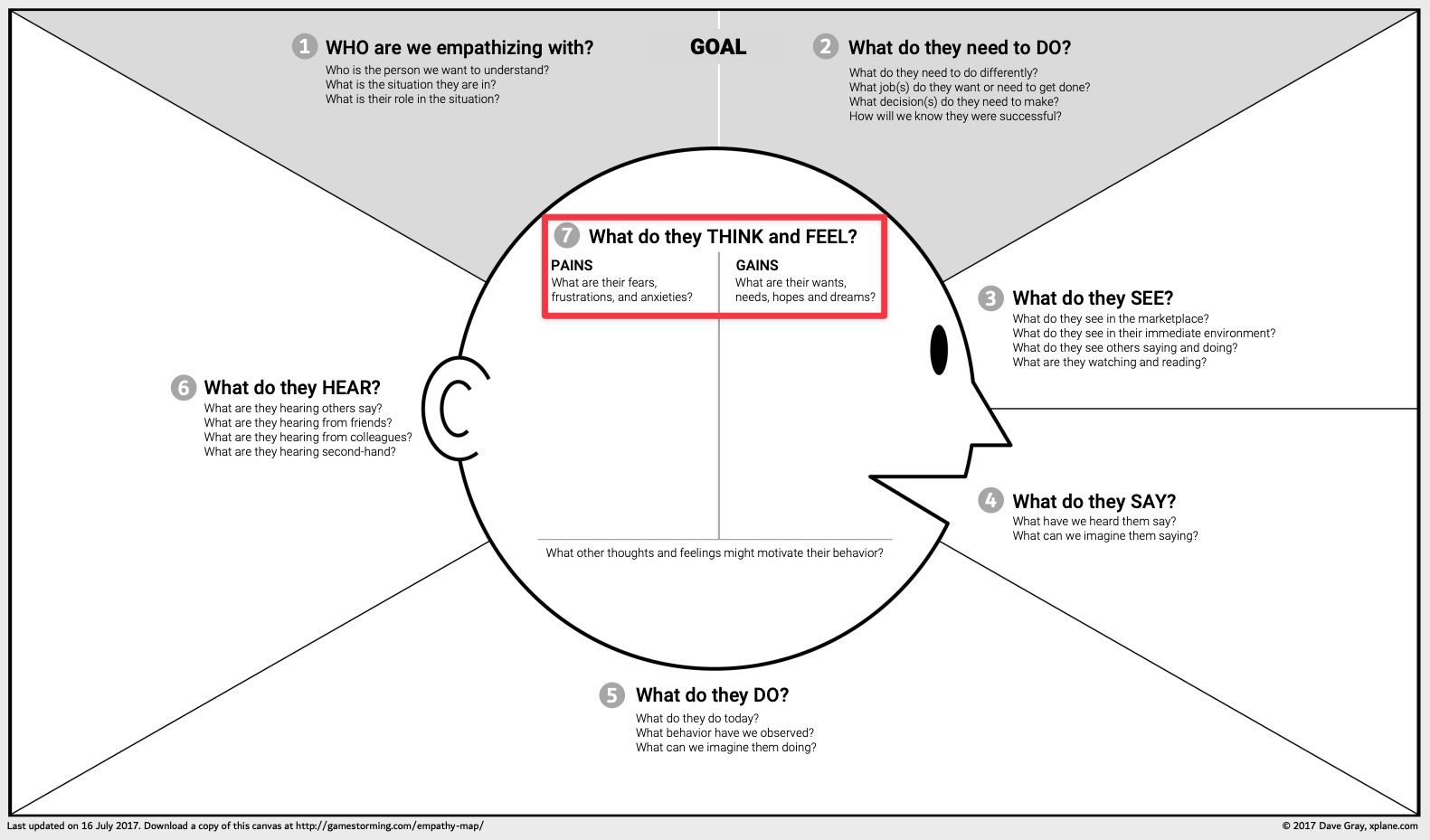Hey friend,
So far, we've explored the outer world of our audience. We've looked at what they see, say, do, and hear.
By exploring what happens around your persona, you hopefully have a better idea of what happens within them — their thoughts and feelings.
Now is the time to check whether what you've guesstimated in parts one (who) and two (what) was true. Maybe you're not sure, and that's fine. In a future course, we'll see how to use what we have now in user interviews.
Let’s first see the focus on this part of the empathy map:
Pains and gains
During Sales Safari, we’ve been looking at people’s needs and wants. Lo and behold, we see them also mentioned on the Empathy Map Canvas:

But on an empathy map, we’re asked what specifically might be plaguing our audience. In other words, we’re sharpening our mental picture of our persona some more.
We do this by thinking what their pains and gains are:
- Pains are what your persona is struggling with right now, either as thoughts or emotions.
- Gains are what your persona hopes to achieve, be it to think, feel, or act differently.
Let’s get started with pains, which are often perceived as emotions:
What does your persona feel?
This is where a bit of creativity is necessary. What someone says they feel isn’t always what they feel. That’s because feelings are fuzzy and difficult to put into words.
But however imperfect, we need to try to relate to our persona on an emotional level (which is yet another reason to create for your past self).
Here are two prompts to fill in this part of the empathy map:
What keeps your persona awake at night?
What worries or scares your persona so much that they’re staring holes into the ceiling at night? This question is a cliché, but that’s only because it’s true. Everybody has something that nags them when it’s dark and silent; know what that is for your persona.
What are their frustrations?
A level less intense but still in the pain territory are the frustrations our persona experiences. What’s working but should just be easier to do? Making people’s lives easier is worth just as much as solving hard pains (it’s just more difficult to sell).
What does your persona think?
As a Stoic, I believe that thoughts and emotions are connected. How we think largely determines how we feel.
So, if you can change how you think (your mental state), you'll also be able to take much more ownership over your emotional state.
Here are two prompts to think about what your persona is thinking and how it may affect their feelings:
What are their needs and wants?
This prompt doesn’t need much introduction; most of your Sales Safari notes are hopefully about your persona’s wants and needs. Needs are what your persona needs to solve right now, whereas wants can be grouped under nice to have (though you’ll have more success if you can help people save or make money).
What are their hopes and dreams?
Know what your persona dreams of if they could wave a magic wand and solve their problems. Many excellent product ideas come from early adopters willing to work with unpolished products to solve longtime pains. Know the people in your audience who are dreaming big.
Recap and what’s next
That’s it for today and this week! Here’s what we covered in this lesson:
- Know people's pains and dreams to help them. We set out to create the empathy map with an assumption of who our audience is and what they want. Now that we deeply know what their pains and wanted gains are, we’re in a much better position to help our persona.
- Emotions are our biggest motivators. If we know how our persona feels and can help them think differently, we can make a lasting impact on them.
- What we think influences how we feel. We live more in our heads than our ancestors, but that doesn’t mean we’re without feelings. Everything that happens around us and what we think about influences our emotions.
In tomorrow’s Weekly Course newsletter, I’ll summarize this week’s course and give you my lessons learned from writing it. I’ll also share some stats about subscriber counts, opening rates, etc.
Next week, we’ll switch over to the Personal Knowledge Management pillar, as I’ll share my entire content creation process — from start to finish. If you’ve always wanted to see how to use these “Tools for Thought” to ship 1,000 words daily, follow next week’s course.
For now, have a great time journaling, and as always:
I hope to read from you!
—Ramses




